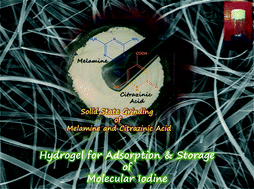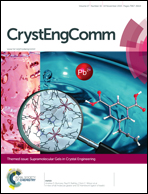A two-component hydrogelator from citrazinic acid and melamine: synthesis, intriguing role of reaction parameters and iodine adsorption study†
Abstract
Herein, we have implemented an intimate grinding–mixing protocol (GMP) for the synthesis of a new hydrogelator from citrazinic acid and melamine. Sonication, just for a few seconds, of the ground mixture in a suitable solvent/mixed-solvent system finally results in the formation of a gel matrix. Citrazinic acid is decorated with ureidopyrimidone functionalities and melamine is enriched with aminopyridine functionalities. Therefore, the necessary non-covalent interactions (like hydrogen bonding and π–π stacking) become part-and-parcel of this reaction, bringing a nanofibrous gel material into existence. A thorough and complete solvent-dependent gelation investigation suggests that water must be present as the sole solvent or one of the members of other mixed-solvent systems to successfully result in gel formation. The gel shows an entangled network morphology. Different micro-analytical studies (FTIR, powder XRD, FESEM, TEM, rheology, etc.) have been conducted for complete characterization of the gel sample. The gel also exhibits stimuli-responsive behaviour towards different interfering chemical parameters like pH, selective anions, etc. Again, it is worth mentioning that here, GMP plays a key role in strongly initiating and improvising solid-state self-assembly. Different non-covalent interactions afford a suitable hydrogen-bonded motif which presumably propagates upon activation in solution phase after mild sonication, favouring the spontaneous formation of fibrous architectures. It is also noticed that without grinding, the solid-state interactions are jeopardized and only a partial gel structure prevails. Finally, the available porosity in the gel framework and the enriched π-electron density within the structure make the gel a suitable host for adsorption of guest molecules. This information provoked us to study the reversible adsorption–desorption equilibrium of molecular iodine within the dried-gel matrix. The guest iodine entrapment into the host occurs both from the solution and also from gas-phase iodine. The complete analysis suggests that our material presents a high storage capacity for this halogen species. Therefore, the study prescribes that the synthesized hydrogel material could be a suitable candidate for application in synthetic organic chemistry and would find an avenue to solve other environmental issues also.

- This article is part of the themed collection: Supramolecular Gels in Crystal Engineering

 Please wait while we load your content...
Please wait while we load your content...